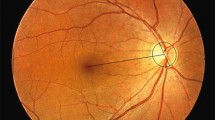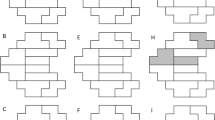Abstract
We evaluated the relevance of interocular asymmetry of optic disc size to the level of intraocular pressure and the extent of optic disc and visual field changes in normal-tension glaucoma (NTG). Fifty-two eyes of 26 patients with NTG were measured for optic disc topography using a computerized image analysis system (IMAGEnet, Topcon), diurnal intraocular pressure (IOP), and Octopus automated visual field. Of the 26 patients, 22 had interocular asymmetry of the optic disc area of at least 0.01 mm2 and of mean IOP of at least 0.3 mmHg. Of these 22 patients, 8 had the higher mean IOP in the eye with the larger optic disc. In these 8 patients, the visual field defect was significantly more advanced in the eye with the larger optic disc (Wilcoxon signed ranks test, P < 0.05). These findings appear to support the hypothesis that an eye with a large optic disc may be more vulnerable to a rise in IOP.
Similar content being viewed by others
References
Abdalla MI, Hamdi M (1970) Applantation ocular tension in myopia and emmetropia. Br J Ophthalmol 54:122–125
Armaly MF (1970) Optic cup in normal and glaucomatous eyes. Invest Ophthalmol Vis Sci 9:425–429
Burk ROW, Rohrschneider K, Noack H, Völcker HE (1992) Are large optic nerve heads susceptible to glaucomatous damage at normal intraocular pressure? A three-dimensional study by laser scanning tomography. Graefe's Arch Clin Exp Ophthalmol 230:552–560
Cartwright MJ, Anderson DR (1988) Correlation of asymmetric damage with asymmetric intraocular pressure in normal tension glaucoma (low tension glaucoma). Arch Ophthalmol 106:898–900
Chi T, Ritch R, Stickler D, Pitman B, Tsai C, Hsieh FY (1989) Racial differences in optic nerve head parameters. Arch Ophthalmol 107:836–839
Crichton A, Drance SM, Douglas GR, Schulzer M (1989) Unequal intraocular pressure and its relation to asymmetric visual field defects in low-tension glaucoma. Ophthalmology 96:1312–1314
Dandona L, Quigley HA, Brown AE, Enger C (1990) Quantitative regional structure of the normal human lamina cribrosa: a racial comparison. Arch Ophthalmol 108:393–398
David R, Zangwill L, Stone D, Yassur Y (1987) Epidemiology of intraocular pressure in a population screened for glaucoma. Br J Ophthalmol 71:766–771
Flammer J, Jenni F, Bebie H, Keller B (1987) The Octopus glaucoma G1 program. Glaucoma 9:67–72
Grant WM, Burke JF Jr (1982) Why do some people go blind from glaucoma. Ophthalmology 89:991–998
Haefliger IO, Hitchings RA (1990) Relationship between asymmetry of visual field defects and intraocular pressure difference in an untreated normal (low) tension glaucoma population. Acta Ophthalmol 68:564–567
Jonas JB, Gusek GC, Nauman GOH (1988a) Optic disc, cup and neuroretinal rim size configuration and correlations in normal eyes. Invest Ophthalmol Vis Sci 29:1151–1158
Jonas JB, Gusek GC, Naumann GOH (1988b) Optic disc morphometry in high myopia. Graefe's Arch Clin Ophthalmol 226:587–590
Leopold IH (1984) Perspectives in drug therapy of glaucoma. In: Drance SM, Neufeld AH (eds) Glaucoma: applied pharmacology in medical treatment. Grune & Stratton, Orlando, pp 1–22
Littmann H (1982) Zur Bestimmung der wahren Größe eines Objekts auf dem Hintergrund des lebenden Auges. Klin Monatsbl Augenheilkd 180:286–289
Mansour AM (1991) Racial variation of optic disc size. Ophthalmic Res 23:67–72
Martin MJ, Sommer A, Gold EB, Diamond EL (1985) Race and primary open-angle glaucoma. Am J Ophthalmol 99:383–387
Perkins ES, Phelps CD (1982) Open angle glaucoma, ocular hypertension, low-tension glaucoma, and refraction. Arch Ophthalmol 100:1464–1467
Quigley HA, Brown AE, Enger C, Drance SM (1990) The size and shape of the optic disc in normal human eyes. Arch Ophthalmol 108:51–57
Tomlinson A, Phillips GI (1969) Ratio of optic cup to optic disc. In relation to axial length of eyeball and refraction. Br J Ophthalmol 53:765–768
Tuulonen A, Airaksinen J (1992) Optic disc size in exfoliative, primary open angle, and low-tension glaucoma. Arch Ophthalmol 110:211–213
Varma R, Steinmann WC, Spaeth GI, Wilson RP (1988) Variability in digital analysis of optic disc topography. Graefe's Arch Clin Exp Ophthalmol 226:435–442
Varma R, Douglas GR, Steinmann WC, Wijsman K, Mawson D, Spaeth GL (1989) A comparative evaluation of three methods of analyzing optic disc topography. Ophthalmic Surg 20:813–819
Author information
Authors and Affiliations
Rights and permissions
About this article
Cite this article
Tomita, G., Nyman, K., Raitta, C. et al. Interocular asymmetry of optic disc size and its relevance to visual field loss in normal-tension glaucoma. Graefe's Arch Clin Exp Ophthalmol 232, 290–296 (1994). https://doi.org/10.1007/BF00194478
Received:
Revised:
Accepted:
Issue Date:
DOI: https://doi.org/10.1007/BF00194478




